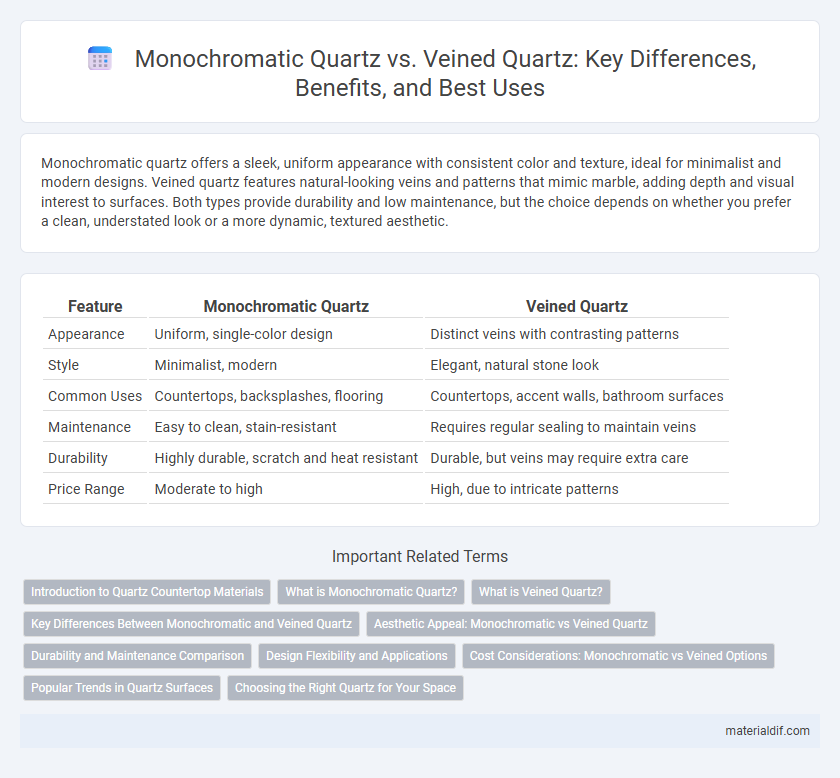Monochromatic quartz offers a sleek, uniform appearance with consistent color and texture, ideal for minimalist and modern designs. Veined quartz features natural-looking veins and patterns that mimic marble, adding depth and visual interest to surfaces. Both types provide durability and low maintenance, but the choice depends on whether you prefer a clean, understated look or a more dynamic, textured aesthetic.
Table of Comparison
| Feature | Monochromatic Quartz | Veined Quartz |
|---|---|---|
| Appearance | Uniform, single-color design | Distinct veins with contrasting patterns |
| Style | Minimalist, modern | Elegant, natural stone look |
| Common Uses | Countertops, backsplashes, flooring | Countertops, accent walls, bathroom surfaces |
| Maintenance | Easy to clean, stain-resistant | Requires regular sealing to maintain veins |
| Durability | Highly durable, scratch and heat resistant | Durable, but veins may require extra care |
| Price Range | Moderate to high | High, due to intricate patterns |
Introduction to Quartz Countertop Materials
Monochromatic quartz countertops offer a uniform, solid color that provides a sleek and consistent appearance, ideal for minimalist and modern kitchen designs. Veined quartz mimics the natural veining found in marble, delivering a sophisticated, elegant look with intricate patterns that add visual depth to surfaces. Both quartz types are engineered from natural quartz crystals combined with resin, offering exceptional durability, stain resistance, and low maintenance compared to natural stone options.
What is Monochromatic Quartz?
Monochromatic quartz features a uniform color throughout the slab, offering a sleek and consistent appearance ideal for minimalist and modern design aesthetics. Its single-tone palette enhances the perception of space and light, making it a popular choice for kitchen countertops and bathroom vanities. Unlike veined quartz, which showcases intricate patterns and natural stone-like veins, monochromatic quartz provides a smooth, solid look that complements a wide range of interior styles.
What is Veined Quartz?
Veined quartz features natural or engineered patterns of lines and streaks that create a dynamic, textured appearance, contrasting with the uniform look of monochromatic quartz. These veins are typically composed of minerals such as feldspar or mica, adding visual depth and character to countertops or surfaces. Veined quartz is prized for its unique aesthetic, often mimicking the natural veining found in marble, making it a popular choice in interior design.
Key Differences Between Monochromatic and Veined Quartz
Monochromatic quartz features a consistent, uniform color throughout the slab, offering a sleek and modern appearance ideal for minimalist designs, while veined quartz displays natural, flowing patterns that mimic marble, providing an elegant and dynamic aesthetic. The key difference lies in the visual texture: monochromatic quartz emphasizes solid color saturation, whereas veined quartz showcases intricate veining that adds depth and character. Durability and maintenance are similar for both types, but veined quartz may better conceal minor wear or stains due to its patterned surface.
Aesthetic Appeal: Monochromatic vs Veined Quartz
Monochromatic quartz features a uniform color that creates a sleek, minimalist aesthetic ideal for modern and contemporary spaces. Veined quartz displays intricate patterns and natural-looking veins, adding depth and visual interest that mimic the luxurious appeal of natural marble. Both styles enhance interior design, with monochromatic quartz offering simplicity and veined quartz providing dynamic elegance.
Durability and Maintenance Comparison
Monochromatic quartz features a consistent color and pattern, offering high durability and resistance to scratches and stains due to its engineered composition. Veined quartz, with its intricate natural-like veining, maintains similar durability but may require more frequent cleaning to preserve the visual contrast and avoid buildup in crevices. Both types are low-maintenance, non-porous, and highly resistant to damage, making them ideal for kitchen countertops and high-traffic surfaces.
Design Flexibility and Applications
Monochromatic quartz offers exceptional design flexibility with its uniform color and consistent texture, making it ideal for minimalist and modern interior applications such as countertops, wall cladding, and flooring where a seamless look is desired. Veined quartz, characterized by natural-looking veins and patterns, provides dynamic aesthetics suitable for statement pieces and luxurious settings, enhancing kitchen islands, bathroom vanities, and feature walls with its intricate design. Both types are highly durable and non-porous, but veined quartz allows for more creative expression in spaces requiring visual depth, while monochromatic quartz supports sleek, understated elegance.
Cost Considerations: Monochromatic vs Veined Options
Monochromatic quartz typically costs less than veined quartz due to its simpler design and more efficient manufacturing process. Veined quartz, which mimics natural stone patterns, involves more intricate craftsmanship, resulting in a higher price point. When budgeting for quartz countertops, selecting monochromatic options can provide a cost-effective solution without sacrificing durability or quality.
Popular Trends in Quartz Surfaces
Monochromatic quartz surfaces continue to dominate popular trends due to their sleek, uniform appearance and versatility in modern interior design, offering a clean and minimalist aesthetic favored in kitchens and bathrooms. Veined quartz, mimicking natural stone with intricate patterns and varied textures, has surged in popularity as it combines the durability of engineered quartz with the luxurious appeal of marble or granite. Both styles provide low-maintenance, durable options, but monochromatic quartz aligns more with contemporary spaces while veined quartz appeals to those seeking a statement piece with natural elegance.
Choosing the Right Quartz for Your Space
Monochromatic quartz offers a sleek, uniform appearance, ideal for minimalist and modern interiors where consistency and subtlety are desired. Veined quartz, featuring natural-looking patterns and dynamic veining, adds character and depth, making it suitable for spaces that aim for a luxurious or classic aesthetic. Selecting the right quartz depends on your design goals, with monochromatic quartz emphasizing simplicity and veined quartz enhancing visual interest.
Monochromatic Quartz vs Veined Quartz Infographic

 materialdif.com
materialdif.com